The Black Oystercatcher (Haematopus bachmani) is a charismatic shorebird found along the rocky coastlines of the Pacific Northwest.
With its striking black plumage, vivid orange-red bill, and haunting calls echoing across coastal cliffs, this species captivates the attention of birdwatchers and nature enthusiasts alike.
Renowned for its specialized feeding habits, the Black Oystercatcher plays a crucial role in coastal ecosystems by foraging on shellfish and controlling populations of bivalves.
Forming monogamous pairs and nesting in secluded locations, these birds exhibit fascinating behaviors throughout their life cycle.
Despite facing threats from habitat loss, pollution, and human disturbance, conservation efforts strive to protect the Black Oystercatcher and its coastal habitats, ensuring the preservation of this iconic species for generations to come. Stay sharp.
Individualizing Criteria of Black Oystercatcher
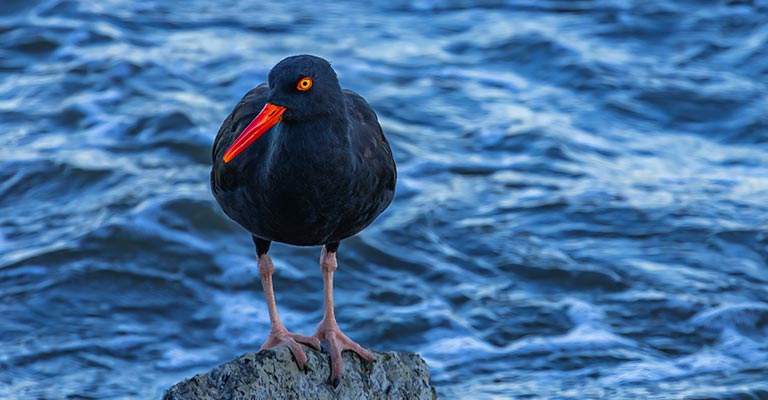
The Black Oystercatcher (Haematopus bachmani) is a distinctive coastal bird native to the Pacific coast of North America. Identifying this species requires attention to specific physical characteristics and behavior.
Here are some of the key points to consider when identifying a Black Oystercatcher:
Size and Shape
Black Oystercatchers are medium-sized shorebirds with a stout body, long legs, and a strong, straight bill. They typically measure around 42-45 centimeters in length, with a wingspan of approximately 70-80 centimeters.
Their body shape is streamlined, allowing them to navigate rocky shores and coastal habitats with ease.
Coloration
As their name suggests, Black Oystercatchers have predominantly black plumage. Their feathers are glossy and black, with a contrasting bright orange-red bill and eye-ring.
This vivid coloration makes them easily recognizable against the muted tones of their rocky coastal environment.
Distinctive Bill
One of the most striking features of the Black Oystercatcher is its long, bright orange-red bill. This robust bill is slightly flattened and tapered towards the tip, ideal for prying open shellfish and probing into crevices for food.
The color contrast between the bill and the bird’s black plumage is a key identifying characteristic.
Legs and Feet
Their legs are long and sturdy, adapted for traversing rocky terrain and wading in shallow water.
The feet of the Black Oystercatcher are webbed, aiding in stability on slippery surfaces and facilitating efficient swimming when necessary.
Behavior
Black Oystercatchers are often observed foraging along rocky shorelines, using their powerful bills to pry open shellfish such as mussels and limpets. They may also be seen probing into crevices and turning over rocks in search of prey.
Their distinctive high-pitched calls, described as a series of piping whistles, are another characteristic feature often heard along the coast.
Habitat
These birds are typically found in coastal habitats, including rocky shorelines, tide pools, and sandy beaches.
They prefer areas with abundant intertidal food sources, such as shellfish beds and exposed rocks, where they can nest and forage.
Flight Pattern
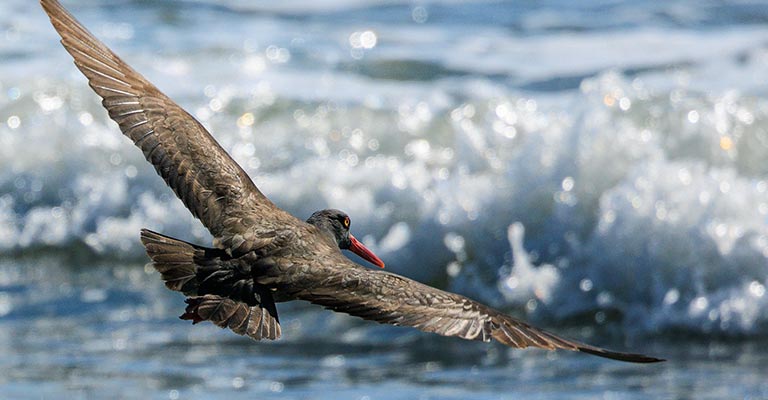
When in flight, Black Oystercatchers display broad, rounded wings and swift, direct flight. Their black plumage and contrasting orange-red bill are easily visible against the sky, aiding in identification even at a distance.
Breeding Season
During the breeding season, Black Oystercatchers may exhibit territorial behavior, defending nesting sites along the shoreline.
Nesting pairs can be observed engaging in courtship displays, including mutual preening and vocalizations, which can help confirm their identity.
Identifying a Black Oystercatcher involves recognizing its distinctive black plumage, bright orange-red bill, and habitat preferences along rocky coastal areas.
Paying attention to their behavior, vocalizations, and breeding season can further aid in accurate identification.
Taxonomy of Black Oystercatcher
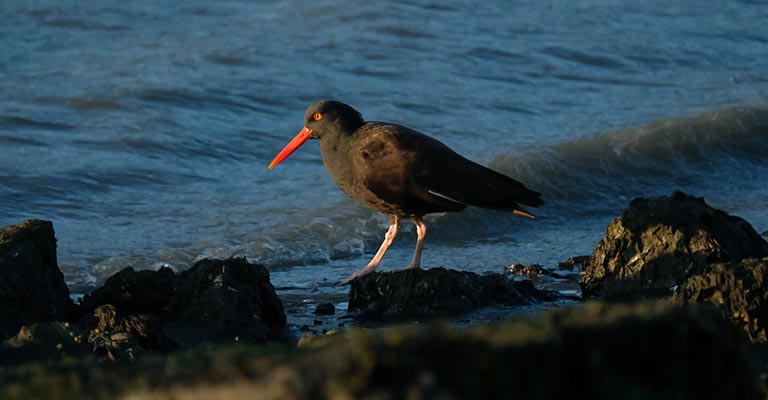
Go through the following table outlining the taxonomy details of Black Oystercatcher:
| Domain | Eukaryota |
| Kingdom | Animalia |
| Phylum | Chordata |
| Class | Aves |
| Order | Charadriiformes |
| Suborder | Charadrii |
| Family | Haematopodidae Bonaparte, 1838 |
| Genus | Haematopus |
| Species | H. bachmani |
The Black Oystercatcher (Haematopus bachmani) belongs to the family Haematopodidae within the order Charadriiformes. This order encompasses a diverse group of shorebirds, including plovers, sandpipers, and gulls.
Within the family Haematopodidae, the Black Oystercatcher is one of eleven species worldwide.
It is closely related to other oystercatcher species, such as the Eurasian Oystercatcher (Haematopus ostralegus) and the American Oystercatcher (Haematopus palliatus).
The genus name “Haematopus” is derived from the Greek words “haima” (blood) and “pous” (foot), referring to the red coloration of its legs. The species name “bachmani” honors the American naturalist John Bachman.
Hunting Habit of Black Oystercatcher
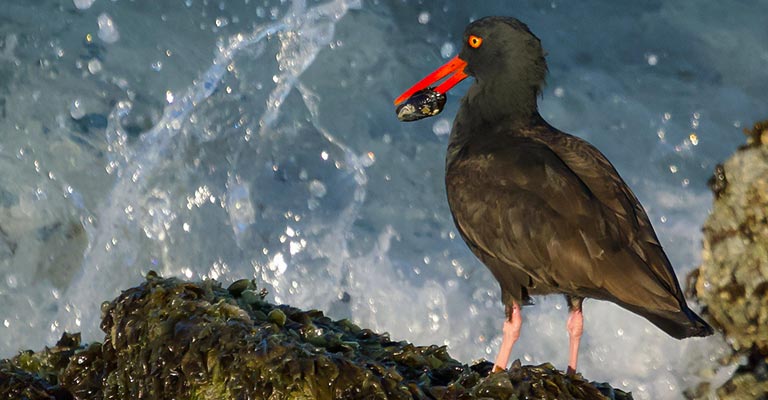
The Black Oystercatcher is a specialized shorebird with a distinctive hunting habit centered around feeding on mollusks and other intertidal invertebrates.
Utilizing its strong, sharp bill, the bird forages along rocky shorelines, probing into crevices and prying open shellfish such as mussels, limpets, and clams.
With remarkable precision, it locates and captures its prey, often turning over rocks and debris to access hidden food sources. Their hunting strategy involves persistence and patience as they meticulously explore their coastal habitat for sustenance.
The bird’s webbed feet aid in stability on slippery surfaces, allowing it to navigate tidal pools and shallow waters with ease. During low tide, Black Oystercatchers are particularly active, taking advantage of exposed feeding grounds.
This hunting habit is not only essential for their survival but also plays a crucial role in shaping coastal ecosystems by controlling populations of bivalves and other prey species.
Black Oystercatcher Life History
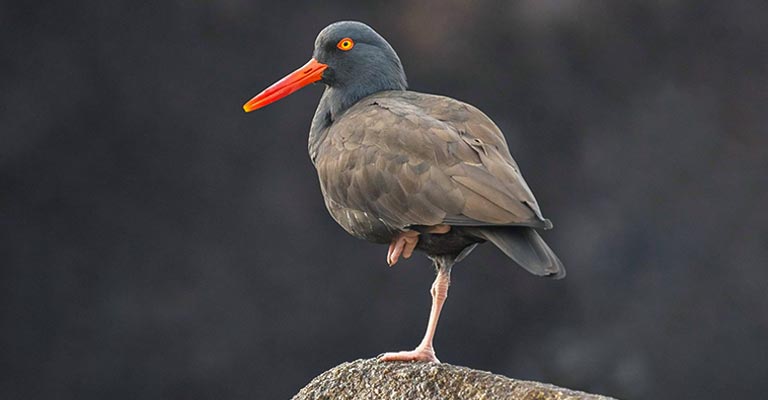
The Black Oystercatcher (Haematopus bachmani) is a fascinating coastal bird native to the Pacific coast of North America.
With its striking appearance and specialized hunting habits, the life history of the Black Oystercatcher offers insights into its ecological role and conservation status.
Food
Black Oystercatchers primarily feed on mollusks such as mussels, limpets, and clams.
They use their strong, sharp bill to pry open shellfish and probe into crevices for hidden prey. Occasionally, they may also consume small crustaceans and marine worms found in intertidal zones.
Habitat
These birds inhabit rocky shorelines, tide pools, sandy beaches, and coastal islands along the Pacific coast. They prefer areas with abundant intertidal food sources and suitable nesting sites.
Range Map
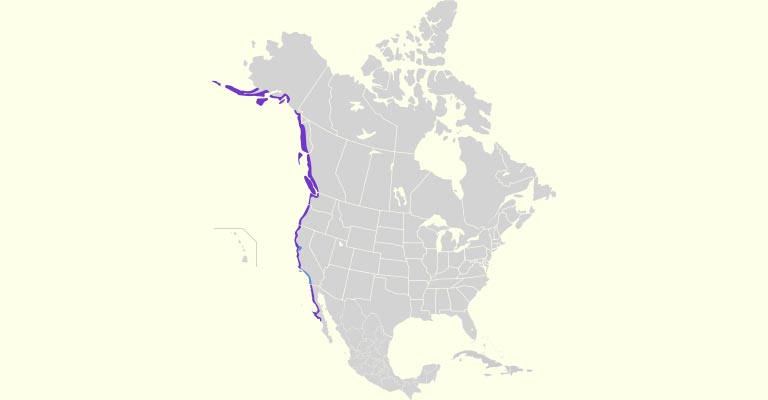
The range of the Black Oystercatcher extends from Alaska through British Columbia, Washington, Oregon, and down to California.
They are typically found in coastal habitats within this range, with some populations being resident year-round while others may migrate short distances.
Nesting
Black Oystercatchers nest on rocky shores or coastal islands, often in secluded locations to avoid disturbance.
Their nests are shallow scrapes in the sand or gravel lined with bits of shell or other debris. Breeding pairs may reuse the same nesting site in successive years.
Here’s a table detailing the nesting details of the Black Oystercatcher:
| Nesting Details | Facts |
| Clutch Size | 1-3 eggs |
| Number of Broods | Simple scrape on sandy or gravel substrate, sometimes lined with shell fragments or debris. |
| Egg Length | Approximately 5.5 – 6.5 centimeters |
| Egg Width | Approximately 3.5 – 4.5 centimeters |
| Incubation Period | 25-28 days |
| Nestling Period | Approximately 4 weeks |
| Egg Description | Light buff to pale brown with black blotches or streaks |
| Nest Type | Simple scrape on sandy or gravel substrate, sometimes lined with shell fragments or debris |
This table provides a concise overview of the nesting habits of the Black Oystercatcher, including clutch size, incubation period, egg characteristics, and other relevant details.
Black Oystercatchers nest in shallow scrapes on rocky shores or coastal islands, typically lined with shell fragments or debris.
The female lays 1-3 eggs, which are incubated by both parents for about 25-28 days. Nesting pairs may reuse the same site in successive years.
During the incubation period, both parents take turns guarding the nest and foraging for food. Once the eggs hatch, the chicks are precocial and leave the nest shortly after birth.
Both parents care for the chicks, feeding them regurgitated food until they are ready to fledge, which occurs approximately four weeks after hatching.
Breeding
Breeding season for Black Oystercatchers typically occurs from March to August. Pairs engage in courtship displays, including mutual preening and vocalizations.
Females lay 1-3 eggs, which are incubated by both parents for about 25-28 days. Chicks are precocial and leave the nest shortly after hatching, being cared for and fed by both parents.
Diseases and Treatment
Black Oystercatchers may be susceptible to various diseases and parasites, including avian malaria and avian pox.
Monitoring of population health is crucial for early detection and treatment of diseases, which may involve veterinary care and management of habitat quality.
Conservation
Conservation efforts for Black Oystercatchers focus on protecting their coastal habitats, minimizing disturbance during the breeding season, and monitoring population trends.
Collaborative initiatives involving researchers, conservation organizations, and government agencies aim to ensure the long-term viability of Black Oystercatcher populations across their range.
By addressing threats such as habitat loss, pollution, and human disturbance, these efforts contribute to the preservation of this iconic coastal bird species.
10 Fun Facts About Black Oystercatchers
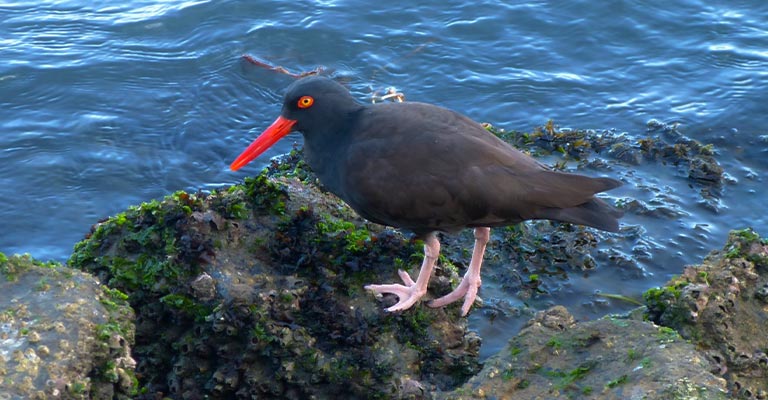
The Black Oystercatcher (Haematopus bachmani) is a charismatic shorebird that inhabits the rocky coastlines of the Pacific Northwest.
Beyond its striking appearance and specialized feeding habits, there are many fascinating aspects to discover about this unique bird species. Here are 10 fun facts about the Black Oystercatcher:
- Distinctive Call: Black Oystercatchers are known for their high-pitched, piping whistles that echo along coastal cliffs and rocky shores. These calls serve as territorial signals and communication between mates.
- Monogamous Bonds: Once they find a mate, Black Oystercatchers typically form monogamous pairs that last for multiple breeding seasons. They engage in courtship displays, including mutual preening and vocalizations.
- Mussel Mastery: These birds are masters at prying open shellfish, particularly mussels, with their strong, sharp bills. They use precise techniques to access the nutritious meat inside, making them a vital part of coastal ecosystems.
- Coastal Dwellers: Black Oystercatchers are exclusively coastal birds, rarely straying far from the rocky shorelines, tide pools, and sandy beaches that provide their primary habitat.
- Nesting Sites: They nest in shallow scrapes on rocky or gravelly substrates, often in secluded locations to avoid disturbance. Nest sites are typically lined with shell fragments or other debris.
- Egg Camouflage: The eggs of Black Oystercatchers have a cryptic coloration, ranging from light buff to pale brown with black blotches or streaks. This helps camouflage them against the rocky background, providing protection from predators.
- Parental Care: Both parents share the responsibilities of incubating the eggs and caring for the chicks once they hatch. They feed their young regurgitated food, consisting of small invertebrates until the chicks are ready to forage on their own.
- Migratory Behavior: While some populations of Black Oystercatchers are resident year-round, others may undertake short-distance migrations, moving to warmer areas during the winter months.
- Conservation Concerns: Despite their adaptability, Black Oystercatchers face threats from habitat loss, pollution, human disturbance, and climate change. Conservation efforts are underway to protect their coastal habitats and ensure their long-term survival.
- Iconic Coastal Species: Black Oystercatchers are iconic symbols of the rugged Pacific coastline, captivating birdwatchers, and nature enthusiasts with their striking appearance and fascinating behaviors. They serve as ambassadors for the conservation of coastal ecosystems and the diverse wildlife they support.
Wrapping Up
The Black Oystercatcher is a remarkable coastal bird with a wealth of intriguing characteristics.
From its distinctive appearance and specialized feeding habits to its monogamous bonds and vital role in coastal ecosystems, this species continues to captivate and inspire conservation efforts.
By appreciating the intricacies of the Black Oystercatcher’s life history, we gain valuable insights into the interconnectedness of coastal habitats and the importance of preserving these fragile ecosystems for future generations. Thank you so much.